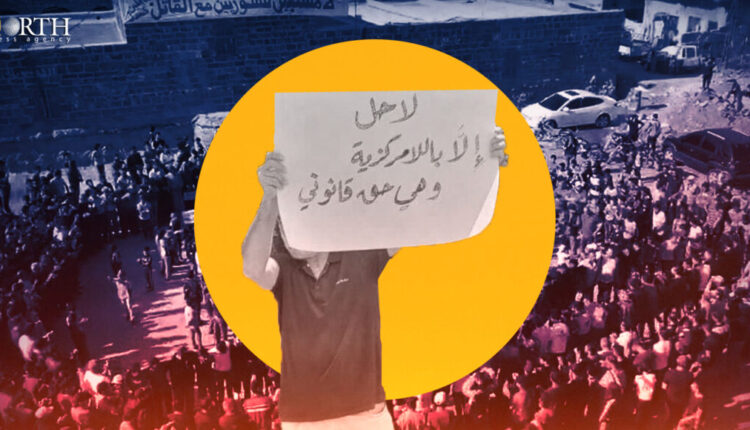
By Stella Youssef
QAMISHLI, Syria (North Press) – Recent resolutions to increase fuel prices by the Syrian government hit the Syrian people, already battered by the consequences of a 12 year-long war, hard, sparking anti-government protests in Daraa and Suwayda governorates in southern Syria. The Syrian government has handled opposition with oppression, will this time be any different?
On August 17, people in Daraa took to the streets in protests due to bad living and economic conditions and demand the Syrian government to leave and to release prisoners.
Soon protests expanded to Suwayda and people demanded the implementation of UN Security Council Resolution 2254 and a decentralized rule as a solution for the conflict in Syria.
Since the Syrian government took control of Daraa in July 2018, the governorate has witnessed increasing security chaos and instability as the government forces did not abide by the settlement agreement.
In July 2018, the armed opposition factions and government forces reached a ceasefire agreement – later known as the settlement agreement – mediated by Russia in the opposition-held areas in Daraa Governorate. Under the deal, the militants of the factions agreed to hand over their heavy weapons in exchange for staying in Daraa, while those who opposed the agreement would be sent to Idlib, which is under the control of Hayat Tahrir al-Sham (HTS, formerly al-Nusra Front).
The government forces began to expand their military posts and violate the settlement’s terms by arresting people who were subject to the settlement, confiscating civilian homes, and killing opponents amid inaction from Russia, the mediator of the agreement.
Since 2018, the Syrian government imposed five unsuccessful settlements on the people of Daraa, causing more disorder and chaos.
All these factors in addition to the devaluation of the Syrian currency and the deteriorating economic conditions exacerbated the situation and sparked protests in both Daraa and Suwayda.
The Druze religious group “Sheikh al-Aql” and local factions in Suwayda also came forth and declared their solidarity with the protestors’ demands.
The governorate of Suwayda is home to the country’s Druze minority, an ethnoreligious group which practices a monotheistic Abrahamic religion and speaks the Arabic language. Many refused to side with either the government or opposition during the country’s civil war, forming independent groups.
An activist told North Press that the Druze leader Sheikh Kikmat al-Hajiri stated his solidarity with the people and stressed to “continue to protest until people’s demands are met, and not to resort to violence.”
The protests are nothing new to the people of Suwayda. In early 2022, they went out in demonstration to enhance dire living conditions. Later, they demanded to form an autonomous administration in the south, which were met with indifference from the government.
Autonomous administration is a form of rule that has been implemented in northeast Syria since 2014 under the name of the Autonomous Administration of North and East Syria (AANES). It was first formed in the Kurdish-majority regions of Afrin, Kobani and Jazira in northern Syria following the withdrawal of the government forces. Later, it was expanded to Manbij, Tabqa, Raqqa, Hasakah and Deir ez-Zor after the Syrian Democratic Forces (SDF) defeated ISIS militarily there. However, the AANES is not officially recognized by the Syrian government.
The Syrian Democratic Council (SDC) also publicly expressed their solidarity with the protestors in Daraa and Suwayda.
The SDC is the political wing of the Syrian Democratic Forces (SDF) and the AANES. It was founded in 2015 and includes all the communities of north and east Syria.
Riyad Dirar, co-chair of the SDC, said they support the people’s demands of peaceful political transition. He also stressed the necessity of ending the authoritarian rule.
“We support and encourage building an administrative project by forming committees consisting of the locals who can manage the region to avoid chaos and not affect the interests of the people in a negative way,” Dirar stated to North Press.
On the other hand, Samira Moubayed, member of the Syrian Constitutional Committee (SCC) for the civil society, told North Press the people of this region know that the government cannot maintain their security or provide their needs.
“The protests will continue until the security of Syria’s south is achieved which is a part of the necessary political change across Syria,” she said.
Few days before the protests erupted, locals in Daraa reported that Syrian government forces have given former leaders of the Syrian opposition powerful position within their ranks to help persecute civilians.
Anwar al-Zubi, a pseudonym for a local group leader affiliated with the government forces, told North Press that former senior leaders of the Syrian opposition were recruited by the government even though they have fought against it before. They use these leaders because they are familiar with those who oppose the government, he added.
Brigadier General Mounir Hariri, a defector of the government forces who lives in Jordan, told North Press that the government forces would not cease their violations in Daraa and would continue pursuing opponents.
“The government forces have no control over Daraa. Therefore, they use sedition and conflicts, fuel tribal feuds, and recruit secret cells to assassinate the opponents then eliminates these cells,” he said.
So far, the Syrian government has not shown a major response towards the protests in southern Syria. However, their reaction to previous protests in Suwyada in December 2022, and the indiscriminate shelling that occurred on August 22 on areas in Daraa in tandem with anti-government protests, indicate that the Syrian government’s approach might not be different from the 2011 harsh crackdown that led to significant destruction, displacement, and loss of lives across Syria.
